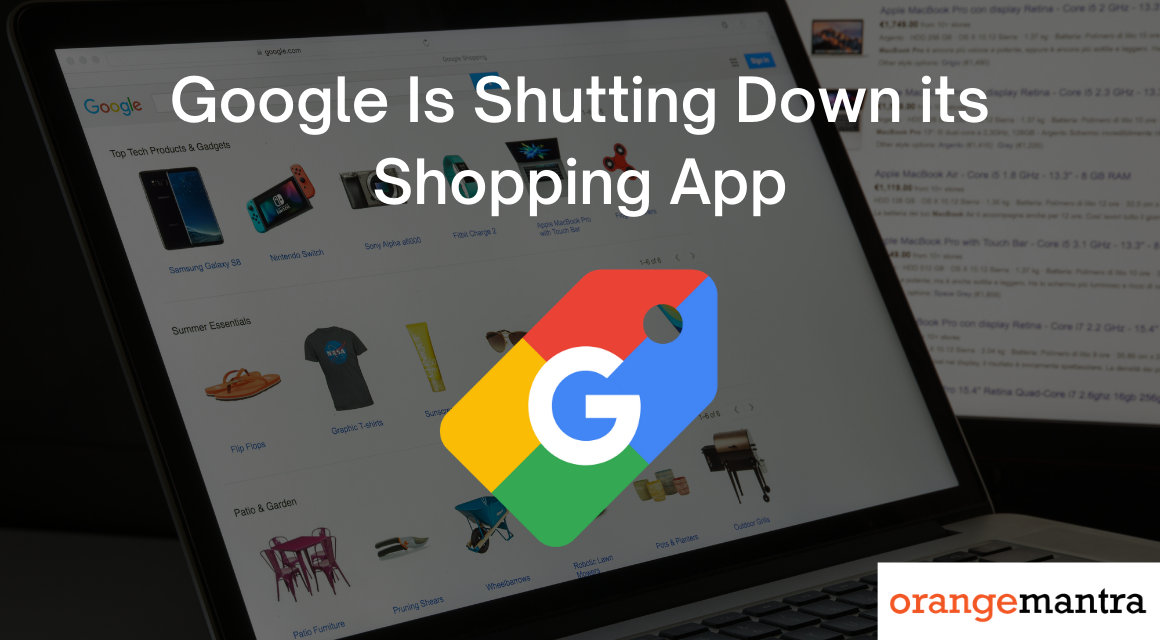Google has planned to discontinue its mobile shopping app, The Verge reported. The app enables users “to shop millions of items across thousands of stores.” According to multiple reports, the tech giant is shutting down its Shopping mobile app for both Android and iOS. Google’s decision may seem contrary to the growing demands for mobile app development services across industries. But the company is not entirely scrapping its shopping platform.
A Google spokesperson said that all the features of the app will be added to the Shopping tab. Earlier, 9to5 Google reported the discovery of the term “sunset” in several strings of the app’s code. It means the app was being discontinued. For shopping app development providers, the move has significant implications.
Google’s Web-Focused eCommerce
How the Google Shopping App Works
The Shopping app enables users to make online purchases using their Google accounts. The app is working normally as of this writing. However, some users are already facing “something went wrong” pop-ups. When you use the Shopping app, you browse products from sellers and advertisers that Google indexes. The app works in a fashion similar to other eCommerce solutions of online merchants.
Offers and deals on Google Shopping are ranked based on relevance. Its algorithms consider your search terms and related Google activity. You can also customize your shopping experience by using filters for price, product category, and brand, among other things.
Enhancing Web Shopping Experiences
Analysts say killing the Shopping app is part of Google’s extensive plan to enhance the overall web experience. Google has been improving the capabilities of its web platforms, including Search, Image Search, and YouTube.
The Android experience of Shopping is almost identical to the web. However, the Android app provides a bottom bar instead of a navigation drawer. Google’s “Home” feed offers a list of recommended products. These recommendations are usually based on the user’s search history and Google activity.
Users can see a list of “Saved” products. The “Notifications” tab offers promotions and order updates. Shoppers also get a “Cart” button that lets them start the checkout process. Users can tap their profile avatar in the search bar to see their orders and purchase history. All these web features are strikingly similar to the ones built using shopping app development services.
Google Shopping’s Future as a Web Platform
Google CEO Sundar Pichai considers Shopping as central to many of the company’s commerce-focused platforms. He has been pushing for Shopping as a service during the pandemic. And that’s not all. Google introduced new price-tracking and analytics tools for the Shopping app. Features like these have become immensely popular in eCommerce solutions of all kinds.
Besides, the Chrome browser has introduced an array of functionality, indicating that Shopping is here to stay- just slightly differently. For instance, the Chrome Cart is a tab page for shopping that allows users to pick up where you left during your online purchase. It covers users’ recent shopping activities across the web. Google has also added a Holiday Gift Guide to its shopping platform.
Wrapping up
The Shopping app is Google’s latest product to join the list of scrapped platforms. The tech titan has ended products like Hangouts, Reader, Plus, and several others. If the app is, indeed, shut down, users might think of transferring their data like shopping lists to other Google platforms. Google’s decision seems to be in sync with the rising popularity of PWAs. When you can get all the features of a native app without installing one, why wouldn’t you use a web solution?
Shopping is killed or not, businesses will continue to push for their visible presence across the web. That means you need an advanced breed of eCommerce solutions to stay ahead. And that’s where vendors like OrangeMantra come into the picture. Using our decades-long experience, we build apps and web solutions that take your online business to a new level. Reach out to us for discussing a failure-proof eCommerce strategy.
FAQs
How much does it cost to develop an eCommerce website?
The costs of building an eCommerce website vary widely, depending on your needs. If you need a simple online store with basic features and a storefront, costs are comparatively lower. OrangeMantra offers reliable eCommerce development at a competitive price.
What does a progressive web app mean?
Progressive web apps are websites that look and feel like an app. PWAs use modern web capabilities to deliver an app-like experience. Users can access all information and capabilities without downloading a mobile app.
What is an omnichannel eCommerce strategy?
An omnichannel eCommerce strategy is an approach to sales and marketing that provides customers with a fully integrated shopping experience. It is achieved by combining user experiences from brick-and-mortar to mobile browsing, to social media everything in between.
How long does it take to develop a B2B eCommerce site?
The development time of a B2B eCommerce site depends on your specific requirements. If you need a design-rich store with large catalogs and numerous features, the development may take longer. We also offer rapid development services for urgent requirements.






















